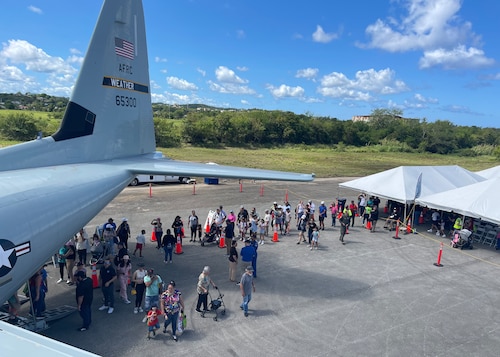Hurricane season starts June 1, and to help communities prepare, the Air Force Reserve Hurricane Hunters and a team of National Oceanic and Atmospheric Administration forecasters visited four Caribbean locations April 16-20 as part of the annual Caribbean Hurricane Awareness Tour.
The CHAT, a joint effort between NOAA's National Hurricane Center and the 403rd Wing's 53rd Weather Reconnaissance Squadron, promotes hurricane awareness and preparedness throughout the Caribbean region.
More than 13,000 people attended this year's event, which stopped at Nassau, Bahamas, Barbados, St. Lucia and Aguadilla, Puerto Rico. Locals were able to tour the WC-130J aircraft and talk to NHC forecasters, Airmen with the 53rd WRS, and a crew member with NOAA's Aircraft Operations Center.
"The goal of the Caribbean Hurricane Awareness Tour is to not only showcase the brave men and women who fly directly into these dangerous storms to collect data for us at the NHC, but to promote a culture of preparedness for the 2024 hurricane season," said Mike Brennan, director of the NHC in Miami. "Now is the time to prepare."
Hurricane season starts June 1 and ends Nov. 30. An "extremely active" hurricane season is likely according to forecasters at Colorado State University. They projected 23 named storms, 11 hurricanes and 5 major hurricanes. NOAA will release their season forecast in late May, but according to Brennan, "regardless of what any season forecast projects, it only takes one storm to hit your area to make it a bad hurricane season."
"This event is a great opportunity for us to educate the public about our mission, how we use the WC-130J to collect data for NHC forecasts, and to stress the importance of heeding forecasts, storm warnings and advisories, and being prepared," said Lt. Col. Ryan Rickert, 53rd WRS chief aerial reconnaissance weather officer.
Weather forecasters rely on satellites for information; however, oceans are data-sparse environments, and satellites can't provide information such as the minimum sea level pressure of a hurricane, wind speed information, or information about the storm structure, which is needed to predict hurricane development and movement, Rickert said.
During a tropical storm or hurricane, 53rd WRS aircrews fly into these systems with the WC130J aircraft at altitudes that range from 500 to 1,500 feet for low-level investigations and up to 10,000 feet for fix missions. During a fix mission, they can fly through the eye of a storm four to six times. During each pass through the eye, crews release a dropsonde







